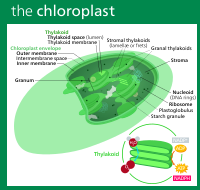
Photo from wikipedia
Transcriptional coordination is a fundamental component of prokaryotic and eukaryotic cell biology, underpinning the cell cycle, physiological transitions, and facilitating holistic responses to environmental stress, but its overall dynamics in… Click to show full abstract
Transcriptional coordination is a fundamental component of prokaryotic and eukaryotic cell biology, underpinning the cell cycle, physiological transitions, and facilitating holistic responses to environmental stress, but its overall dynamics in eukaryotic algae remain poorly understood. Better understanding of transcriptional partitioning may provide key insights into the primary metabolism pathways of eukaryotic algae, which frequently depend on intricate metabolic associations between the chloroplasts and mitochondria that are not found in plants. Here, we exploit 187 publically available RNAseq datasets generated under varying nitrogen, iron and phosphate growth conditions to understand the co-regulatory principles underpinning transcription in the model diatom Phaeodactylum tricornutum. Using WGCNA (Weighted Gene Correlation Network Analysis), we identify 28 merged modules of co-expressed genes in the P. tricornutum genome, which show high connectivity and correlate well with previous microarray-based surveys of gene co-regulation in this species. We use combined functional, subcellular localization and evolutionary annotations to reveal the fundamental principles underpinning the transcriptional co-regulation of genes implicated in P. tricornutum chloroplast and mitochondrial metabolism, as well as the functions of diverse transcription factors underpinning this co-regulation. The resource is publically available as PhaeoNet, an advanced tool to understand diatom gene co-regulation.
Journal Title: Frontiers in Plant Science
Year Published: 2020
Link to full text (if available)
Share on Social Media: Sign Up to like & get
recommendations!